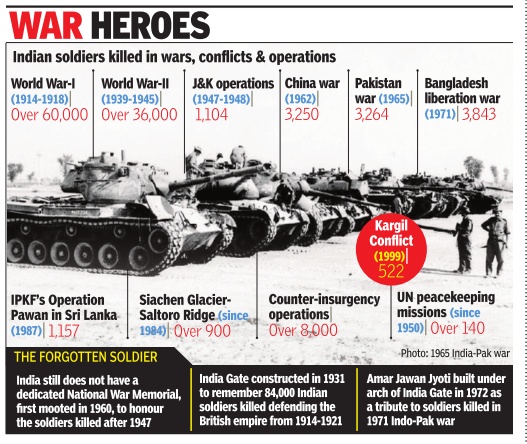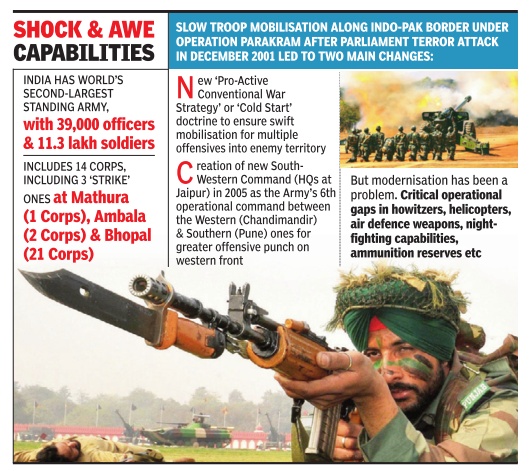Indian Army: History (1947- )


This is a collection of articles archived for the excellence of their content. |
Covert operations
Why these military ops should stay covert by Manimugdha Sharma The Times of India
Surgical strikes in enemy territory have always been kept a secret by Indian forces
Military historian and strategic affairs expert Mandeep Singh Bajwa said he could count at least two dozen instances [between 1947 and May 2015] when India struck inside enemy territory .
“[That is] how militancy in Punjab ended and how it was curbed in Kashmir,” says Bajwa.
1971
In 1971, some very large-scale covert and overt operations were conducted without the Press hearing about it. One of them was Operation Jackpot under which Mukti Bahini commandos were aided and abetted by India to blow up Pakistan's naval assets in the east. This was long before the actual war. “Even before that, there was Operation Windfall where we silently moved two mountain divisions, one towards Balurghat and the other towards Jessore and Khulna. Initially, troops went across in civilian clothes, then in uniform. Pakistanis were completely outclassed and outsmarted by the Indians. That's how wars are fought and won,“ says Bajwa.
The late 1980s, 1990s
“When Pakistan started supporting the Khalistan movement and there were terror attacks on our cities, Rajiv Gandhi decided he had had enough of it. Pakistani cities like Lahore, Multan and Karachi were bombed, which Pakistan claimed were done by RAW . This forced General Zia to sue for peace through the Prince of Jordan and promise withdrawal of support to Sikh militancy ,“ says Bajwa.
His claims are supported by historian Dilip Hiro's 2015 book, The Longest August, which goes on to detail how Benazir Bhutto, after coming to power, promised Rajiv Gandhi that she would totally dismantle the Khalistan support system in Pakistan, triggering the total collapse of the separatist movement.
2000
“Similarly, in Kashmir, terrorism has been curbed through both overt and covert operations. Pakistan blamed India for the 2000 Lanjote massacre, which India denied. But after that, attacks on Hindus in Doda and Rajouri districts stopped,“ says Bajwa.
This is a collection of articles archived for the excellence of their content. |
=1987: ‘A coup was planned,’ Lt Gen Hoon The Times of India, Oct 04 2015
Ajay Sura
Army had plotted to topple Rajiv govt in 1987: Retd Gen
Lt Gen P N Hoon, a former Army commander of the prestigious Western Command, has claimed there was a plot to topple Rajiv Gandhi's government in 1987. He has also claimed that three crack para-commando battalions, including one from the Western Command, were told to move for action in Delhi.
The 86-year-old Hoon, who joined BJP in December 2013 as adviser, defence and security, has alleged that the then Army chief, General KrishnaswamiSundarji, and Lt Gen S F Rodrigues, the vice chief who went on to become Army chief, were involved in the plot. Hoon hints in his just-released book, `The Untold Truth', that the plan for a coup was hatched at the behest of certain very senior politicians who did not share cordial relations with Rajiv . The Lt Gen states that at his farewell function in 1987 hosted by then Punjab governor Siddharth Shankar Ray in Chandigarh, GianiZail Singh had blamed Gandhi of corruption and negligence. Singh also said Rajiv was unconcerned about the 1984 anti-Sikh riots.
Hoon has claimed that as chief of the Western Command in May-June 1987, he was in Delhi on official work when he received a message that a letter had been received at command headquarters from army HQ seeking three paracommando battalions. The battalions included the First-Para Commando, which was under the Western Command, and the 9th and 10th Para Commando, which were under the Northern and Southern Commands. According to Hoon, these three battalions were ordered to be placed under Rodrigues.He said he immediately briefed Rajiv and his principal secretary Gopi Arora about the development and showed them the letter. “I also explained to them how dangerous this move could be, not only for the country , but also for our political system,“ Hoon said. He claims to have ordered the Delhi area commander, under the Western Com mand, not to move any troops without his permission. Hoon, who retired in October 1987, states that one minister in Rajiv's Cabinet, V C Shukla, was aware about the possibility of Army action. In Chapter 10, titled `GianiZail Singh vs Rajiv Gandhi', he says Shukla specially came down to Chandimandir to meet him. Hoon, however, concluded that Zail Singh didn't take any action against Rajiv's government fearing that it would lead to transfer of power from a democratically elected government to the armed forces.
Air Marshal Randhir Singh, a veteran of many wars, disagrees with Hoon and says there's never been any attempt at a military coup.Terming it Gen Hoon's “own perception,“ Colonel K S Pathak, a veteran and one of the founders of the special forces, says there may have been mobilization of troops in Delhi but it was for other reasons.